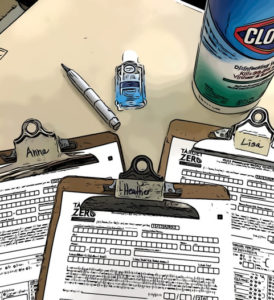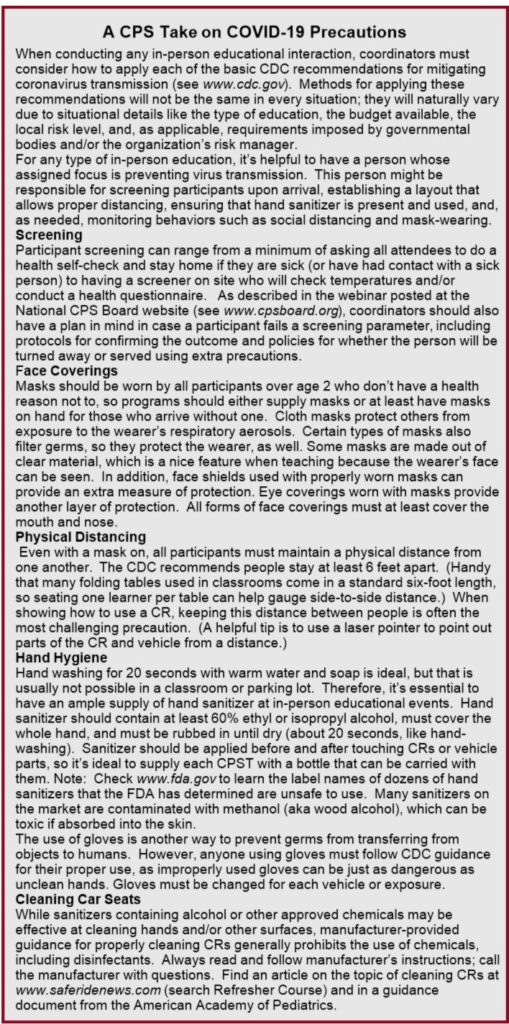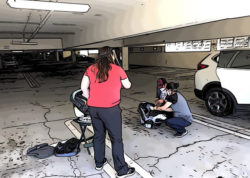Virtual education has filled in many educational gaps during this year of pandemic, but some CPS programs are cautiously conducting in-person education, as well. Those that do must employ many new approaches in order to mitigate risk while ensuring quality of service.
Everyone in the CPS community is on a learning curve when it comes to adding COVID-19 precautions to educational efforts, from in-classroom to checkups to certification courses. The following provides guidance learned from early adapters. (Also, see a helpful recorded webinar.)
Over time, there’s no doubt that clever CPSTs will come up with even more ways to function efficiently and safely in this new environment. If you have ideas or resources to share with the CPS community, please let SRN know by emailing info@saferidenews.com.
Certification Courses
Conducting the National CPS Technician Certification Training (the official name for the new version of the curriculum, launched in February) has been more challenging due to the pandemic, but with proper precautions, several teams have put on courses in 2020. According to Safe Kids, nearly 2,000 CPSTs have been certified nationwide this year. Naturally, lead instructors need to know and follow any local government requirements for gatherings, which will generally align with the good-sense approach of limiting classes to smaller sizes during this time.
In addition to an impressive array of resources posted by the National CPS Board to help introduce the new curriculum, www.cpsboard.org has a guidance document to help course instructors, leads, assistants, and sponsors in their efforts to conduct safe and healthy trainings during the pandemic. In addition, detailed descriptions (with photos) of two successful trainings that were held this spring are included in the National CPS Board webinar.
In-Person Checkups

Whether conducting in-person checks by appointment, at a checkup event, or as the required final skills evaluation for the new curriculum, CPSTs must take several precautions when doing checkups in person.
Special attention must be given to physical distancing. To follow recommendations, each CR check scenario requires ample space around the vehicle. Be sure to allow enough space for the caregiver(s) to step outside the vehicle while maintaining at least six feet from the CPST. It’s prudent to allow this amount of space on both sides and behind the vehicle, since often all vehicle seats and sometimes the trunk or cargo area are accessed during a checkup. Therefore, expect checkups in which multiple caregivers are present at the same time (such as at a checkup event) to require far more space than usual.
In a parking lot, park vehicles so there is ample space not only between the caregiver and CPST, but also between each of the CPST/caregiver groupings. If using fire station bays, make sure the width of the bay has ample space to maintain appropriate distance on each side of the vehicle, and don’t allow vehicles to pull up too close to each other.
A key decision will be whether the checkup will be hands-off or not. Will the CPST enter the caregiver’s vehicle? Touch their CR? Hand them paperwork? There are many approaches that can be taken, so it is important to determine ahead of time the amount of touching that will be tolerated, communicate that decision to everyone involved, and establish a protocol to help ensure that everyone complies.
For instance, if CPSTs will be touching a caregiver’s CR and/or vehicle, determine how to maintain physical distance between caregivers and CPSTs. A good plan is to keep caregivers on one side of the vehicle while the CPST stays on the other. If touching a caregiver’s property, plan at minimum to use hand sanitizer before and after doing so; some organizations may implement additional precautions. For instance, in Maryland, caregivers are advised that, prior to starting the checkup, the rear seats of their vehicle (with the CR covered) will be misted with a quaternary ammonium chloride solution, an EPA recommended disinfectant. (This and other aspects of Maryland’s very comprehensive draft protocol are included in the National CPS Board webinar, mentioned above.)
It is also possible to conduct in-person events that are entirely hands-free. By requiring preregistration, precheck information, including a signed hold-harmless agreement, can be gathered electronically before the event, so paperwork/pens do not need to be handled by anyone other than CPSTs on the day of the event. Preregistration communication should also urge expectant caregivers to bring a bath towel and their own doll or stuffed animal so that pool noodles and practice dolls need not be shared.
For the hands-off approach, it’s very useful to have an ample supply of demo car seats on hand so that each CPST can model proper usage from a safe distance (ideally, using the same or similar CR model). Laser pointers are a great tool for pointing from a distance. Small tables (like sturdy TV trays) set six or more feet apart can be beneficial for facilitating a comfortable teaching arrangement that also helps everyone remember to maintain proper distancing.
Classroom Education
 Group education for the public can be very effective in a virtual format. For instance, the webinar at www.cpsboard.org describes how a program in Washington state has continued education for contracted child services transporters by transitioning awareness courses to an online format. That webinar also describes how a program in Southern California has approached offering in-person education for situations that are less conducive to online learning.
Group education for the public can be very effective in a virtual format. For instance, the webinar at www.cpsboard.org describes how a program in Washington state has continued education for contracted child services transporters by transitioning awareness courses to an online format. That webinar also describes how a program in Southern California has approached offering in-person education for situations that are less conducive to online learning.
In addition to the basic precautionary methods (spacing, mask-wearing, etc.), using clear laminate barriers/panels can be an extra precaution used in a classroom. Such barriers could be placed between the instructor and students or wrap around each participant (such as acrylic desk dividers). The California program described above devised clear laminate barriers/panels on wheels that can be repositioned to accommodate a dynamic teaching environment.
Unfortunately, personal protective equipment can often make communication difficult. Some people have a hard time hearing voices that are muffled by face coverings or other protection. To make matters worse, many people are less able to speak loudly when wearing a mask. And, when it is hard to hear or be heard, it is natural to step closer to one another, which must be avoided right now. Therefore, for a class that is both safe and effective, pay attention to sound quality and amplification. Make an extra effort to avoid scheduling classes in settings with a lot of background noise. Whenever possible, arrange for instructors to use voice amplification technology, even in smaller spaces where a microphone would not typically be necessary. A cordless lavalier-type or headset microphone is ideal for most types of CPS education, as these are hands-free and allow freedom of movement. (Tip: Keep extra batteries on hand!)
Also, note that wearing a clear-panel mask (available online), rather than one that obscures much of the face, improves one’s ability to communicate with many people, including lip readers, some individuals on the autism spectrum, and young children.

